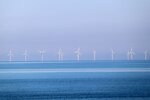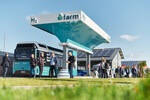08/25/2008
USA - Far-offshore wind farms could be solution to energy issues
Picture 400 super-size windmills spinning in a steady, stiff ocean breeze miles off the coasts of California, New England, the mid-Atlantic, Washington state, the Great Lakes and the Gulf of Mexico. Even as Congress is embroiled in a sharp debate over whether to allow increased offshore oil and gas drilling, others are seriously working to develop a green source of energy along the outer continental shelf.
The winds blowing 15 miles or even farther off the U.S. coasts potentially could produce 900,000 megawatts of electricity, or roughly the same amount as nearly all the nation's existing power sources combined, according to Department of Energy estimates. Though the cost of these deepwater offshore wind farms isn't firm, some estimate the electricity they would produce could be nearly comparable in price to that generated at today's power plants. Norway, Denmark, Britain and other European nations are already developing such offshore wind projects.
"This is an energy frontier we are just starting to explore," said Walter Musial, a senior engineer with the Energy Department's Wind Technology Center in Colorado, adding that far offshore windmill projects in the United States could start appearing between 2012 and 2015. While some near-shore projects have sparked controversy because the giant windmills could be visible from the coastline, Musial and other engineers and scientists say they are looking at projects mostly at or beyond the horizon.
"This is not a betting man's game, but the potential is immense, no question about that," said Burton Hamner, president of Grays Harbor Ocean Energy Co., which has already identified a windmill site about a dozen or so miles off the Washington coast. "On the few days you could see them from shore, they would be about the size of your thumbnail."
Offshore winds are generally stronger and blow more consistently than those over land. Land-based wind turbines produce electricity about one-third of the time. A far offshore wind turbine could operate between 45 percent and 50 percent of the time. "It's a grand vision and technically it is feasible, but nothing is solid," Hamner said. Other industry officials are more skeptical.
"We are aware there are some folks noodling around on this, but it's not on our drawing boards," said Terry Oliver, chief technology and innovation officer for the Bonneville Power Administration, the federal power marketing authority that supplies about 45 percent of wholesale electricity in the Northwest. Jeff King, a senior resource analyst at the Northwest Power and Conservation Council, said far offshore wind power would not be part of the updated five-year regional energy plan. "I'm not saying the technology won't be developed, but deepwater is pretty speculative at this point," King said. Even so, the idea has its proponents.
"This is a slam dunk," said George Hart, chief technical officer at the Ocean Energy Institute, a Maine-based research center. "None of this is high-tech. It can be done." The first offshore units likely will be built off the mid-Atlantic states, where shallower water presents less of a technological challenge. The continental shelf on the Pacific Coast is much narrower and deep water is much closer to shore.
But Hamner said he has found a 60-mile long, 30-mile wide shelf in the Pacific stretching north from the mouth of the Columbia River that could be ideal for offshore wind farms. The shelf was formed by sediment caught by northerly currents as it flows out of the Columbia. The water is about 250 feet deep, and windmills could be set on platforms or anchored to the seabed using existing technology.
In deeper water, engineers are designing floating platforms that could hold a windmill. Such floating platforms, attached by cables to weights on the seabed, are already in widespread use in the offshore oil industry. "The farther offshore, the better the wind," said George Hagerman, a research faculty member at Virginia Tech's Advanced Research Institute. The offshore wind turbines could produce twice as much electricity as those on shore, Hagerman said. The current state-of-the-art terrestrial wind generators can generate five megawatts of power, while some of the offshore wind turbines on the drawing boards could generate 10 megawatts. "Chances are we will see full-scale prototype units in the next five years," he said.
There have been discussions of hybrid offshore wind farms in which generators capable of converting the motion of waves into energy are attached to windmill platforms. The swells coming out of the Gulf of Alaska toward the Northwest coast make the region potentially one of the best sites in the world for wave turbines. And some have even suggested the electricity produced at offshore wind farms could be used to power offshore projects to produce hydrogen through electrolysis of seawater. The hydrogen could be then transported onshore aboard tankers and used to fuel such things as hydrogen-powered cars.
The United States has major wind corridors off the West Coast, East Coast, Great Lakes and in the plains states from North Dakota to west Texas. If a super-national grid was built, wind energy could be shipped from one end of the country to the other. If the wind wasn't blowing in one area of the nation, electricity generated from wind power elsewhere could be shipped in from another region. "The wind will always be blowing somewhere," Hart said.
The winds blowing 15 miles or even farther off the U.S. coasts potentially could produce 900,000 megawatts of electricity, or roughly the same amount as nearly all the nation's existing power sources combined, according to Department of Energy estimates. Though the cost of these deepwater offshore wind farms isn't firm, some estimate the electricity they would produce could be nearly comparable in price to that generated at today's power plants. Norway, Denmark, Britain and other European nations are already developing such offshore wind projects.
"This is an energy frontier we are just starting to explore," said Walter Musial, a senior engineer with the Energy Department's Wind Technology Center in Colorado, adding that far offshore windmill projects in the United States could start appearing between 2012 and 2015. While some near-shore projects have sparked controversy because the giant windmills could be visible from the coastline, Musial and other engineers and scientists say they are looking at projects mostly at or beyond the horizon.
"This is not a betting man's game, but the potential is immense, no question about that," said Burton Hamner, president of Grays Harbor Ocean Energy Co., which has already identified a windmill site about a dozen or so miles off the Washington coast. "On the few days you could see them from shore, they would be about the size of your thumbnail."
Offshore winds are generally stronger and blow more consistently than those over land. Land-based wind turbines produce electricity about one-third of the time. A far offshore wind turbine could operate between 45 percent and 50 percent of the time. "It's a grand vision and technically it is feasible, but nothing is solid," Hamner said. Other industry officials are more skeptical.
"We are aware there are some folks noodling around on this, but it's not on our drawing boards," said Terry Oliver, chief technology and innovation officer for the Bonneville Power Administration, the federal power marketing authority that supplies about 45 percent of wholesale electricity in the Northwest. Jeff King, a senior resource analyst at the Northwest Power and Conservation Council, said far offshore wind power would not be part of the updated five-year regional energy plan. "I'm not saying the technology won't be developed, but deepwater is pretty speculative at this point," King said. Even so, the idea has its proponents.
"This is a slam dunk," said George Hart, chief technical officer at the Ocean Energy Institute, a Maine-based research center. "None of this is high-tech. It can be done." The first offshore units likely will be built off the mid-Atlantic states, where shallower water presents less of a technological challenge. The continental shelf on the Pacific Coast is much narrower and deep water is much closer to shore.
But Hamner said he has found a 60-mile long, 30-mile wide shelf in the Pacific stretching north from the mouth of the Columbia River that could be ideal for offshore wind farms. The shelf was formed by sediment caught by northerly currents as it flows out of the Columbia. The water is about 250 feet deep, and windmills could be set on platforms or anchored to the seabed using existing technology.
In deeper water, engineers are designing floating platforms that could hold a windmill. Such floating platforms, attached by cables to weights on the seabed, are already in widespread use in the offshore oil industry. "The farther offshore, the better the wind," said George Hagerman, a research faculty member at Virginia Tech's Advanced Research Institute. The offshore wind turbines could produce twice as much electricity as those on shore, Hagerman said. The current state-of-the-art terrestrial wind generators can generate five megawatts of power, while some of the offshore wind turbines on the drawing boards could generate 10 megawatts. "Chances are we will see full-scale prototype units in the next five years," he said.
There have been discussions of hybrid offshore wind farms in which generators capable of converting the motion of waves into energy are attached to windmill platforms. The swells coming out of the Gulf of Alaska toward the Northwest coast make the region potentially one of the best sites in the world for wave turbines. And some have even suggested the electricity produced at offshore wind farms could be used to power offshore projects to produce hydrogen through electrolysis of seawater. The hydrogen could be then transported onshore aboard tankers and used to fuel such things as hydrogen-powered cars.
The United States has major wind corridors off the West Coast, East Coast, Great Lakes and in the plains states from North Dakota to west Texas. If a super-national grid was built, wind energy could be shipped from one end of the country to the other. If the wind wasn't blowing in one area of the nation, electricity generated from wind power elsewhere could be shipped in from another region. "The wind will always be blowing somewhere," Hart said.
- Source:
- Online editorial www.windfair.net
- Author:
- Edited by Trevor Sievert, Online Editorial Journalist
- Email:
- ts@windfair.net
- Link:
- www.windfair.net/...
- Keywords:
- wind energy, renewable energy, wind turbine, wind power, wind farm, rotorblade, onshore, offshore









